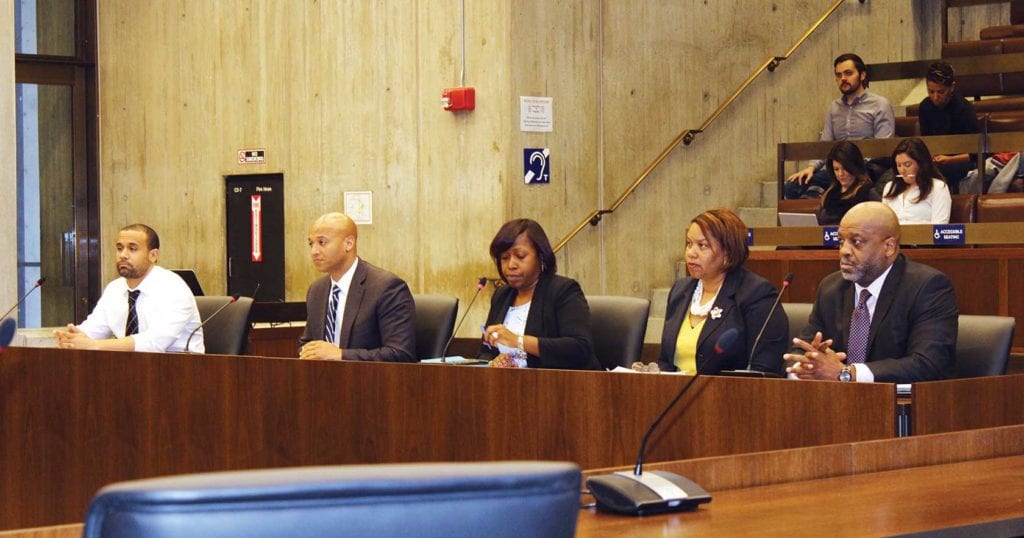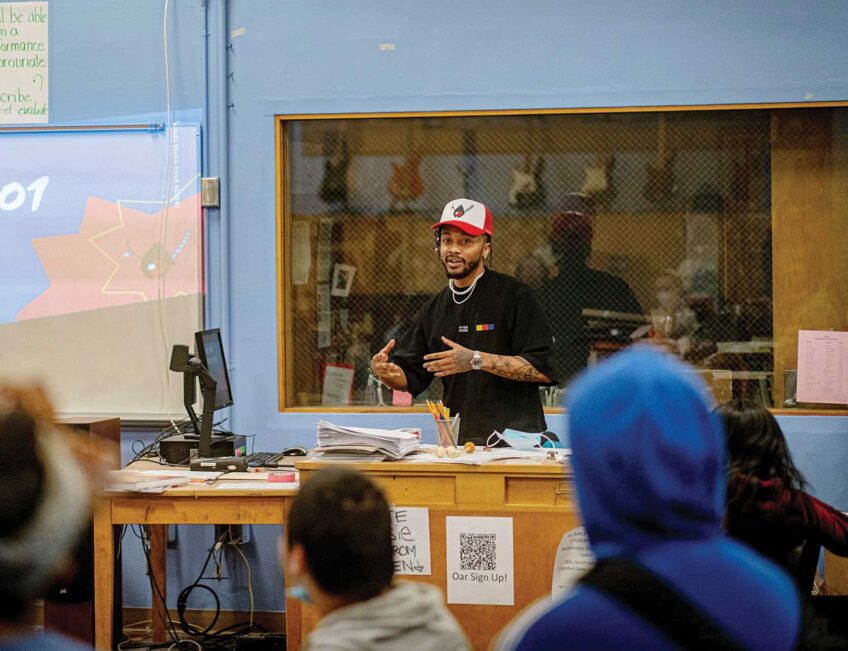
The City Council Committee on Jobs, Wages and Workforce Development, chaired by Councilor Frank Baker, representatives from the Boston Employment Commission (BEC) and other city officials met last week at City Hall to discuss the lack of diversity and economic opportunity for workers of color during the bi-annual review of the Boston Residents Jobs Policy (BRJP).
“Making sure that we’ve got construction jobs that are going to Boston residents, to people of color, to women is very important, particularly if we are talking about ensuring economic opportunity for people in our community and making sure that we are closing the wealth gap,” said Councilor Kim Janey, who co-sponsored the Oct. 25 public hearing with Councilor Lydia Edwards.
The BRJP, approved by former Mayor Raymond Flynn in 1983, mandates that contractors working on any public project, or on private projects exceeding 50,000 square feet, must hire a certain percentage of Boston residents, people of color and women to work on the site. Originally, these standards were set at 50 percent of total work hours to go to Boston residents, 25 percent to people of color and 10 percent to women. The policy was amended in January 2017 and now contractors must ensure that 51 percent of total work hours go to residents, 40 percent to people of color and 12 percent to women.
Christopher Brown, a manager from the BRJP office on the panel before the committee last week, reported that for the 47 projects placed under the purview of the latest ordinance, on average 40 percent of employment hours are going to Boston residents, 51 percent to people of color and 6 percent to women.
His presentation revealed that for all projects monitored between October 2017 and September 2018, these averages fell: 28 percent of working hours on construction sites went to residents, 34 percent to people of color and 5 percent to women.
“It’s easy to be critical about projects not meeting the BRJP goals, and we should not let them off the hook easily,” said BEC Chair Travis Watson, who joined Brown, the mayor’s Chief of Economic Development John Barros, Deputy Director of the Office of Economic Development Sheryce Hearns, and BEC Coordinator Kim Odom on the panel at the hearing. “But if we take a step back,” Watson continued, “Mayor Walsh has helped position us to make real inroads to inclusion and diversity in the construction industry and ensured Boston’s economic growth is both inclusive and equitable for all its residents.”
Contractors and companies are monitored by the BEC, a seven-member board selected by the mayor, as well as members of the BPDA and local activists. Fines starting at $300 are levied against non-compliant employers, and corrective action hearings may be arranged to encourage them to improve their hiring practices and meet the city’s guidelines.
Watson admitted that “the commission has a lot of work to do to ensure that the economic growth of our city is one that provides inclusion and equity for all of Boston’s residents,” but said that the new sanctioning powers granted in 2017 have “brought developers and contractors to the table with a new sense of urgency.”
No fines have been brought against errant employers so far this year, as city officials have favored communication over financial penalties to resolve the issue, said Barros. But he also said that he anticipates fines may be collected by the next review hearing, set for April 2019.
Priscilla Flint, vice president and co-founder of the Black Economic Justice Institute, attested to monitoring seven construction projects in Roxbury over the last six years.
“We attend the BEC meetings and we hear the excuses that come from the developers and contractors about why they’re not compliant,” Flint said. “We see major construction going on and yet our people are not on these jobs. In the year 2018 it is sad the construction industry is still predominantly an all-white male industry.”
Janey noted, “There are a number of jobs on construction sites going on through our city because of this economic boom, and we’ve got to do all that we can to make sure that those jobs are going to our people.”
Describing 2018 as “a record-setting year,” Barros reported that there is $9.8 billion of active construction going on in the city at present, and a further $6.8 billion in the pipeline.
The Office of Economic Development has made some improvements in ensuring more contractors are held accountable when they fall short of BRJP standards. Actions include hiring a director and an outreach coordinator for the Equity and Inclusion Unit within the Office of Economic Development, hiring three new staff members to monitor companies and upgrading data management processes to allow for more accurate and timely reporting.
Barros also mentioned the ongoing work of the disparity study, launched in 2018 and due for completion in 2019. The findings, he said, will shed more light on the contract procurement process, and help the city better understand how to make this a more equitable system that will encourage business owners of color and women to participate.
One of the biggest challenges in ensuring complete compliance, highlighted during the hearing, is contractors who repeatedly fall short of the goals. Presently, there are no requirements for contractors or developers to submit compliance records history, and so many with questionable past records are repeatedly hired to work on projects.
Another way in which companies can skirt BRJP’s standards is by what Councilor Ayanna Pressley, vice chair of the committee who took over for Baker halfway through the hearing, called “double-counting.” Edwards, too, raised the point that employers could hire someone who is black, female and a resident of Boston and this would check all three categories, rather than hiring three separate workers. The panel, rather than confirm her argument, were silenced by her questioning.
Public testimony followed. Six residents and community activists, including Flint and former City Councilor Chuck Turner, spoke of the efficacy of the BRJP and the monitoring efforts of the BEC.
“The BRJP holds much promise, but the results are lacking,” said Don Carlson, a Boston resident and economic development consultant for the NAACP. He said more creative thinking was needed to understand the reasons why more employers aren’t meeting BRJP targets. He suggested establishing a working group to research and analyze the issue.
“Something different needs to be done,” said Carlson. “We need the city to assume good leadership of this issue. No other entity has the combination of power, moral persuasion, resources and the motivation needed to crack this nut.”






